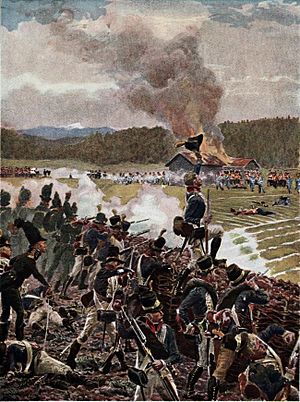Battle of Mobekk facts for kids
Quick facts for kids Battle of Mobekk |
|||||||
|---|---|---|---|---|---|---|---|
| Part of the Dano-Swedish War of 1808–09 | |||||||
 Battle of Mobekk, by Andreas Bloch |
|||||||
|
|||||||
| Belligerents | |||||||
| Commanders and leaders | |||||||
| Strength | |||||||
| 300 | 800 | ||||||
| Casualties and losses | |||||||
| 38 | 40–269 | ||||||
The Battle of Mobekk was a fight that happened on May 18, 1808. It was part of the Dano-Swedish War of 1808–09, a conflict between Sweden and Denmark–Norway. This battle took place during Sweden's attempt to invade Norway.
After a Swedish win at Lier, Norwegian commander Bernhard Ditlef von Staffeldt told Johan Georg Ræder to attack the Swedish forces. The Norwegians pushed some Swedish outposts back across the Skinnarbøl river. However, they faced strong resistance at a Swedish stronghold called Mobekk. Ræder tried to attack this stronghold three times but failed. After five hours of fighting, the Norwegians had to retreat.
This battle did not change the overall war much. The Swedish general, Gustaf Mauritz Armfelt, pulled his troops out of Norway soon after. He had misunderstood orders from the Swedish king, Gustav IV Adolf, who wanted him to stay and defend.
Contents
Why the Battle Happened: Background
After their win at Lier, Swedish General Gustaf Mauritz Armfelt and his soldiers stayed near Lier. They were waiting for the ice on the Glomma river to melt. This would allow them to continue their attack towards the Kongsvinger Fortress.
Other Swedish groups were sent to help Armfelt's position. There were a few small fights in the area, like near Masterud, but nothing big happened.
In the middle of May, the Norwegian commander, Christian August, gave an order. He told Bernhard Ditlef von Staffeldt to attack the Swedish outposts. These outposts were along the Skinnarbøl river, which was on Armfelt's right side.
Staffeldt then ordered Johan Georg Ræder to lead 800 men to attack the Swedish positions. The Swedes had about 300 men there, led by Carl Cederström. The Swedes had several defensive positions, or "entrenchments," north of the river. The most important one was at Mobekk.
The Fight at Mobekk
Ræder's left group of soldiers attacked Mobekk at 11:30 AM. About 90 Swedish soldiers from the Hälsinge and Närke-Värmland regiments defended Mobekk. They were led by Captain Ström.
Soon after, the other Norwegian groups attacked nearby Swedish spots at Skansgarden and Skinnarbøl. The Swedish soldiers there were told to retreat south across the river. They burned the bridge behind them. This stopped the Norwegians from crossing the river.
The Norwegians sent more soldiers to Mobekk, where the fighting was very intense. At 12:00 PM, the Swedes at Mobekk also got help. Forty men from the Värmland Jägers joined them, led by Captain Lagerlöf. He took charge of all the Swedish forces there. In total, about 130 Swedish soldiers faced 450 Norwegians at the Mobekk stronghold.
Swedish soldiers were under heavy fire from Norwegian sharpshooters. These sharpshooters had climbed onto the roofs of nearby houses to get a better aim. The Norwegians tried to storm the stronghold three times. Another group of Norwegians tried to cross the river behind the Swedes. But Lagerlöf's soldiers fought back and pushed them away. The Norwegian attacks on the stronghold were also stopped.
To encourage his friends, a Swedish sergeant named Diricker did something brave. Each time the Norwegians attacked, he climbed onto the defenses. He would wave his hat around, making fun of the enemy.
At 4:45 PM, the Norwegians gave up and retreated. Ræder could not get his soldiers to attack again. The Swedes took back their old positions. Lagerlöf's Jägers chased the retreating Norwegians for more than a kilometre.
What Happened Next: Aftermath
The Norwegians reported that 7 of their men were killed, 27 were hurt, and 6 were captured. Some historians think these numbers are too low, given how hard the fighting was. The Swedes believed the Norwegian losses were much higher. One report said as many as 269 Norwegians were lost, including 16 captured.
The Swedes, who mostly fought from inside their stronghold, had fewer losses. They had 5 men killed and 33 wounded. After the battle, Staffeldt wrote a letter to Christian August. He said that the defeat was because they didn't have enough skilled officers or well-trained soldiers. However, he also praised his soldiers for their bravery.
To get back at the Swedes, Staffeldt led 150 men to attack a small Swedish outpost. This happened at Jerpset during the night of May 24–25. They captured or killed all 29 Swedish soldiers there.
On May 24, General Armfelt received new orders from the Swedish king, Gustav IV Adolf. The king wanted him to move to a better defensive spot. The king planned for British and Swedish forces to land in Zealand and attack Denmark. Armfelt was supposed to just defend his position in Norway.
However, Armfelt misunderstood the king's orders. He began a full retreat from Norway on May 29. By the middle of June, the Swedes had completely left Norway. Only a small group remained at Prestebakke and berby. These soldiers were later surprised and defeated at Prestebakke by a much larger Norwegian force on June 10. They were forced to surrender.
Images for kids


